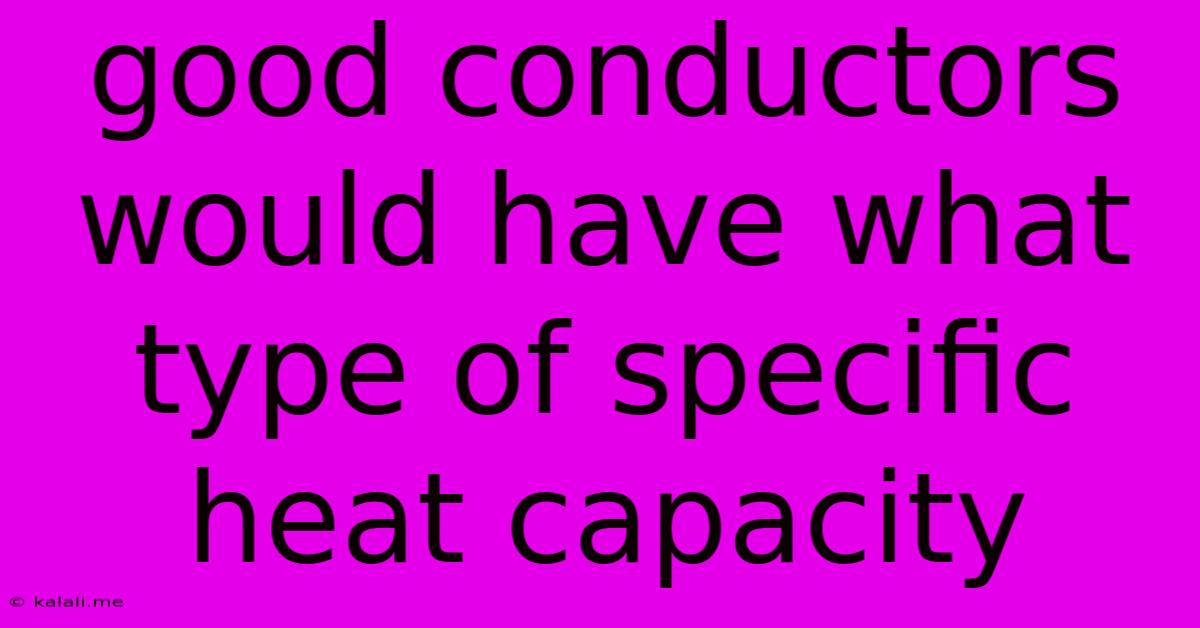Good Conductors Would Have What Type Of Specific Heat Capacity
Kalali
May 31, 2025 · 3 min read

Table of Contents
Good Conductors: Unveiling the Relationship with Specific Heat Capacity
Meta Description: Discover the relationship between thermal conductivity and specific heat capacity. Learn why good conductors of heat generally possess low specific heat capacities, exploring the underlying physics and providing real-world examples.
Understanding the properties of materials is crucial in various fields, from engineering and physics to material science and chemistry. Two key properties often considered together are thermal conductivity and specific heat capacity. While they might seem unrelated at first glance, a fascinating relationship exists, particularly when analyzing good conductors of heat. This article delves into the connection between these properties, explaining why good conductors generally have low specific heat capacities.
What is Thermal Conductivity?
Thermal conductivity describes a material's ability to transfer heat. Good conductors efficiently transmit heat energy, allowing for rapid temperature equalization. Metals like copper, aluminum, and silver are prime examples of excellent thermal conductors due to their free electrons, which readily transport thermal energy. Conversely, materials like wood, rubber, and air are poor conductors, or insulators, resisting heat transfer.
What is Specific Heat Capacity?
Specific heat capacity, often denoted as 'c', quantifies the amount of heat energy required to raise the temperature of one kilogram of a substance by one degree Celsius (or one Kelvin). A high specific heat capacity means a substance can absorb significant heat with a relatively small temperature change. Water, for instance, has a remarkably high specific heat capacity, making it an excellent heat reservoir. A low specific heat capacity, on the other hand, indicates that a small amount of heat leads to a noticeable temperature increase.
The Connection: Good Conductors and Low Specific Heat Capacity
The relationship between thermal conductivity and specific heat capacity is not a direct, absolute correlation, but a general trend: good conductors of heat tend to have low specific heat capacities.
This is because:
-
Free Electrons and Heat Transfer: Many good conductors (metals) possess a "sea" of freely moving electrons. These electrons are highly mobile and readily absorb and transfer kinetic energy, contributing significantly to efficient heat conduction. The same electrons that facilitate rapid heat transfer also limit the substance's capacity to store thermal energy internally; hence, the low specific heat capacity.
-
Atomic Structure and Vibrations: The atomic structure of good conductors also plays a role. While electron movement is dominant in metals, atomic vibrations (phonons) also contribute to heat transfer. In materials with low specific heat capacity, atomic vibrations are less effective at storing thermal energy, leading to faster heat dissipation.
-
Energy Transfer Mechanisms: The dominant mechanism of heat transfer in good conductors is often electronic, as opposed to vibrational. Electronic heat transfer is quick and efficient, leading to a lower capacity for storing heat energy within the material's structure.
Examples of Good Conductors with Low Specific Heat Capacities
- Copper: Excellent thermal conductor, relatively low specific heat capacity.
- Aluminum: Another highly conductive metal with a low specific heat capacity.
- Silver: The best thermal conductor among common metals, it also boasts a low specific heat capacity.
Conversely, materials with high specific heat capacities, like water, are poor thermal conductors.
Conclusion
While exceptions exist, the general principle holds: materials that excel at conducting heat often possess a low specific heat capacity. This is fundamentally linked to the dominant mechanisms of heat transfer within these materials, particularly the role of free electrons in metals. Understanding this relationship is vital for material selection in various engineering and scientific applications, from heat exchangers and electronic cooling systems to thermal management in building design.
Latest Posts
Latest Posts
-
Blood Moon Scriptures In The Bible
Jun 01, 2025
-
What Does Trimming The Tree Mean
Jun 01, 2025
-
How To Delete Usb Flash Drive
Jun 01, 2025
-
Threw Me For A Loop Meaning
Jun 01, 2025
-
How To Save Gta 5 Game
Jun 01, 2025
Related Post
Thank you for visiting our website which covers about Good Conductors Would Have What Type Of Specific Heat Capacity . We hope the information provided has been useful to you. Feel free to contact us if you have any questions or need further assistance. See you next time and don't miss to bookmark.